In cases that involve a statute, there is often a need for statutory interpretation. Some statutes can have straightforward meanings, while others can be ambiguous. In cases where a statute may be vague, judges must step in to decipher the legislative intent.
Statutory Interpretation
The language is the most important part of a statute. If the language itself is straightforward and plain, it must be applied according to its terms. However, if a statute is unclear, the interpretative process begins. Read about this process in the CRS Report, Statutory Interpretation: General Principles and Recent Trends. Why is some legislation unclear? There are a few reasons. The meaning of words can change over time. The emergence of new technology and unforeseen situations make application of existing laws difficult. Additionally, there is a need to compromise with or cater to special interest groups.
This is where canons come into play. Canons provide guidance in interpreting a statute. These canons are used as aids, not “rules of law.” Many of the canons are based on general language principles. See this article, Remarks on the Theory of Appellate Decisions and the Rules or Canons about How Statutes Are to Be Construed, written by Professor Karl Llewellyn, to view a list of some of the canons used. He argues that judges should take into account current circumstances and not rely on these canons as the only possible answer. Llewellyn also argues that every canon has a “counter-canon” that would lead to the opposing interpretation of a statute. Here are some examples of canons:
- Textual: These canons are rules of thumb for understanding the words in the text. For example, when a statute is ambiguous, its meaning can be determined by statues on the same subject matter.
- Substantive: Substantive canons instruct the court to favor interpretations which promote values or policies. For example, in regards to criminal statutes, the court should resolve the ambiguity in favor of the defendant. An example of this can be found in Muscarello v. United States.
- Deference: These canons direct the court to defer to the interpretation of another institution, such as an administrative agency or Congress. For example, if two statutes conflict, the latest statute enacted prevails.
Another way to construe a statute is by looking at the legislative history. A legislative history includes documents such as committee reports, committee hearings, floor debates, and other materials produced during the construction of legislation. There are opposing opinions as to whether this route is effective. In his article Observations about the Use of Legislative History, Kenneth W. Starr discusses the dangers of using utilizing legislative histories. In his opinion, the enacted statute represents the intent of the Congress as a whole, whereas a legislative history contains a multitude of documents from several subdivisions which may have a narrower outlook. Furthermore, he states that a legislative history can allow for manipulation, meaning a judge can find what he or she is looking for within the documents. This route is quite costly for lawyers who need to sift through a legislative history in a depository to study the statute.
Alternatively, others believe that sifting through a legislative history will provide clarity to the original intent of the legislation. In his article Avoiding Judicial In-Activism: The Use of Legislative History to Determine Legislative Intent in Statutory Interpretation, Matthew B. Todd notes that researching a legislative history can provide a broad insight into the intent of a statute, as well as a better understanding of its language. He states that since proposed legislation is drafted and amended, the final language may not adequately delineate the legislators’ intent. Furthermore, committee reports are viewed as the most reliable source of a legislative history because they provide an understanding of the purpose and meaning of the statutory language. Todd believes that a legislative history provides a judge with the experiences and information that aided in the enactment of the law.
Learn More
Interested in learning more about this topic? Use the Full Text tab on the HeinOnline welcome page and enter “judicial statutory interpretation”~10 into the search bar and click the search button. From the results page using the Date facet, narrow down the results to 2010 to date.

Some articles that are relevant to the topic at hand include The Truth Might Set Your Statutory Interpretation Free by Richard Murphy, Debiasing Statutory Interpretation by Alexander I. Platt, and The Dumbing Down of Statutory Interpretation by Glen Staszewski. Notice the ScholarCheck feature available on the right side of the results page that allows a user to view the number of times the title has been viewed in a rolling 12-month period, to view any articles that cite the title, and to view any cases that cite the title. For example, the article On Judicial Discretion in Statutory Interpretation by H. Miles Foy III has been cited by 6 articles and accessed 27 times.
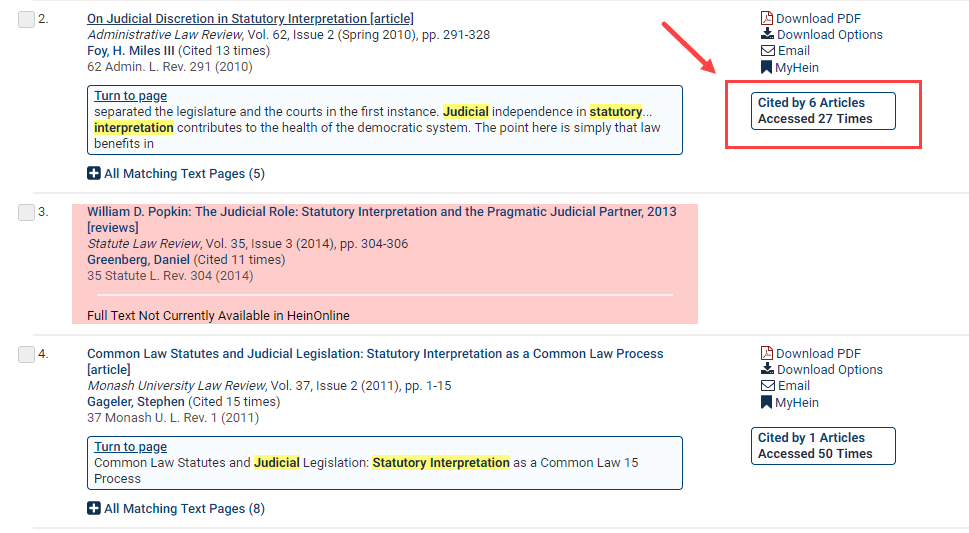
Users can click on the Cited by 6 articles hyperlink to view these articles and further their research. Similarly, when users are viewing the article, the ScholarCheck feature is available next to the Contents tab. Users can also click on this link to view the cited by articles.

While viewing On Judicial Discretion in Statutory Interpretation, users can also click on the More Like This button.
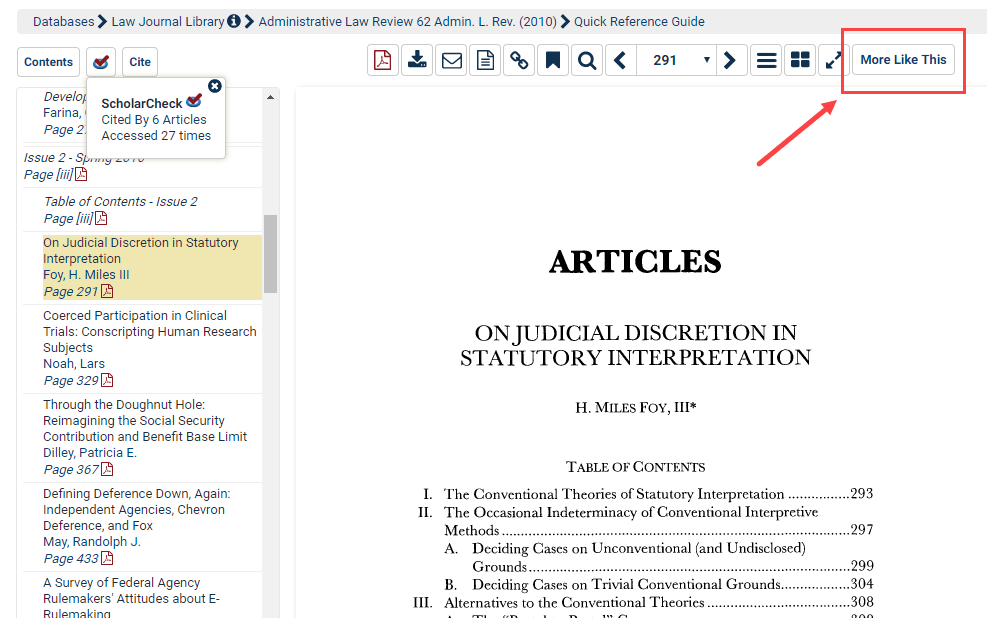
The More Like This button uses machine learning and natural language processing tools which pull out “interesting words,” as determined by an algorithm, from the article being viewed. Users are provided with a list of similar articles, based on the interesting words.
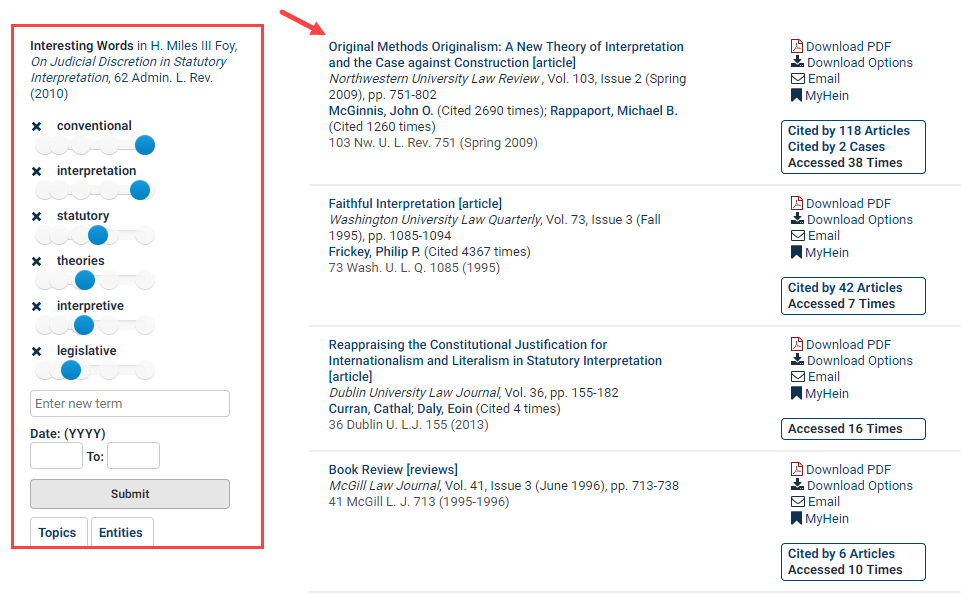
Change the boost factors on the interesting words, enter a new term, or include a date range to change the scope of results.
U.S. Federal Legislative History Library
HeinOnline’s U.S. Federal Legislative History Library includes more than 2,400 titles published by the Government Printing Office and private publishers. With this database, users can research the legislative intent behind major public laws and follow the progression of a bill from its introduction to its passage. Documents typically include bill versions, House and Senate reports, congressional hearings, the full text of a public law, and more related documents. The most frequently accessed content in the past 12 months includes:
- Legislative History of the Tax Reform Act of 1986 : P.L. 99-514 : 100 Stat. 2085 : Oct. 22, 1986
- Omnibus Copyright Revision Legislative History
- Immigration and Nationality Acts. Legislative Histories and Related Documents 1950-1978
- Bankruptcy Reform Act, 1978: A Legislative History
- Internal Revenue Acts of the United States: Revenue Act of 1954 with Legislative Histories and Congressional Documents
Users can locate a legislative history by searching three different ways. First, search by Publication Title. Browse by Title, Author, Date, Subject, or use the A-Z to find a specific title.
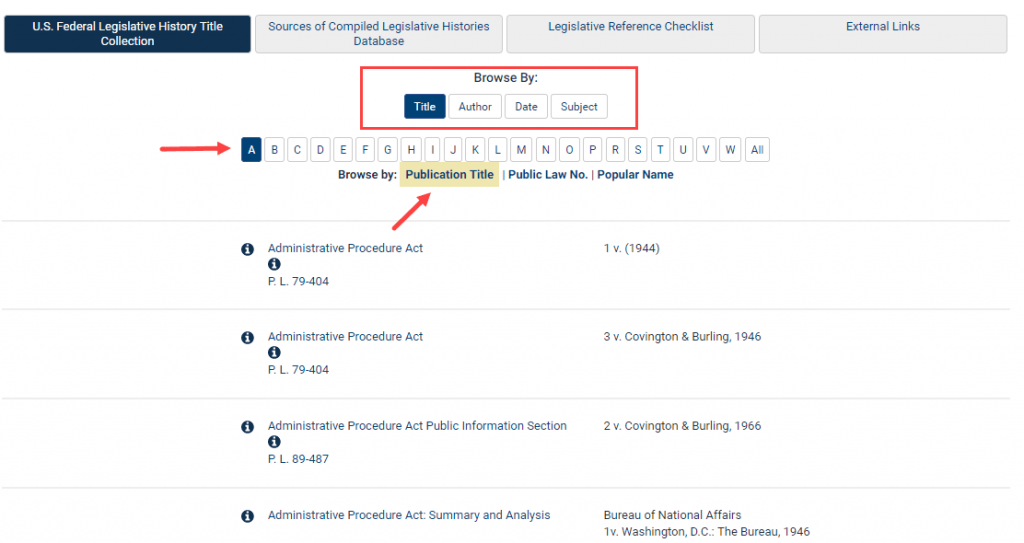
Users can also search using the Public Law No. section. From here, select the Congress number. For example, let’s search for Public Law No. 111-148. Navigate to Congress Number 111.
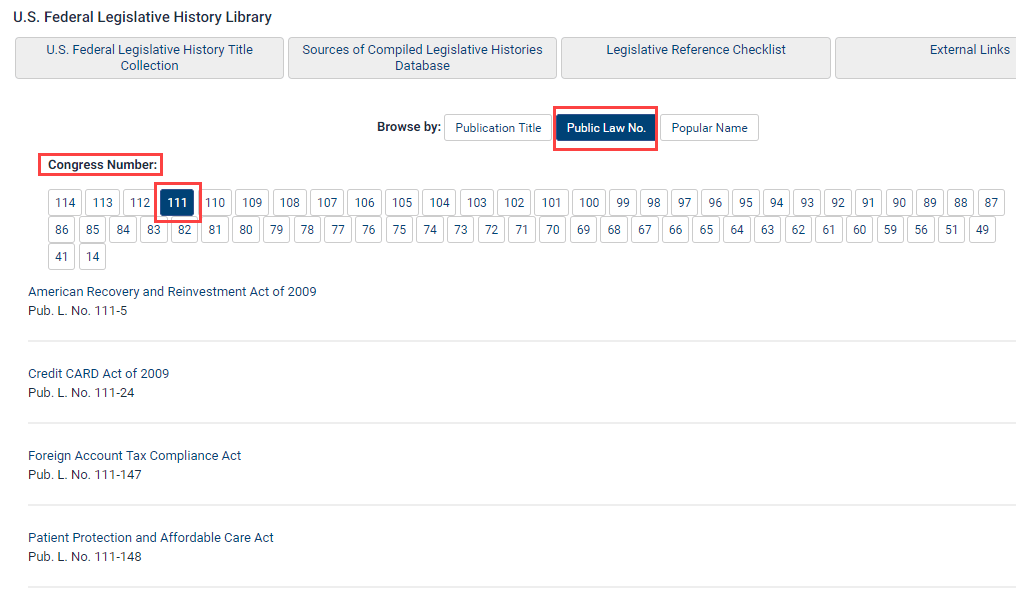
Next, either scroll down to find Pub. L. No. 111-148 or use the CTRL+F function to search for the number. Click on Pub. L. No. 111-148, Patient Protection and Affordable Care Act, to view multiple legislative histories.
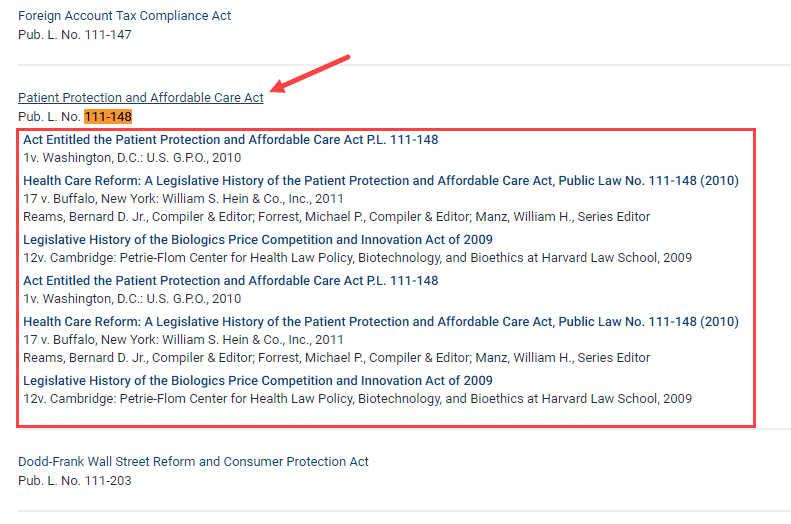
Lastly, users can search by Popular Name. Simply use the A-Z index to locate the name of the Public Law. Navigate to the letter P to locate the Patient Protection and Affordable Care Act.
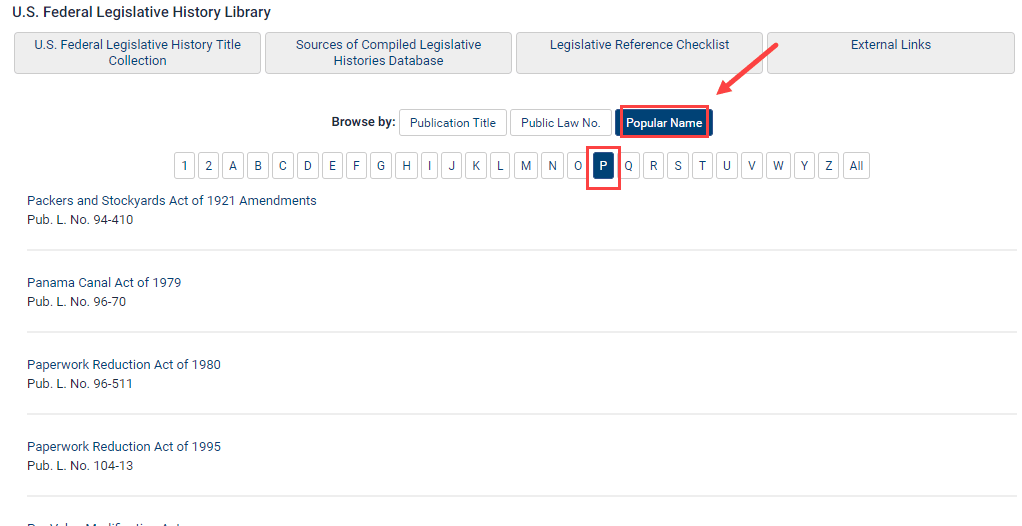
The U.S. Federal Legislative History database also contains the sub-collection Sources of Compiled Legislative Histories. This is a database derived from the publication Sources of Compiled Legislative Histories: A Bibliography of Government Documents, Periodical Articles, and Books originally compiled by Nancy P. Johnson and now being edited by Ronald E. Wheeler and Jenna E. Fegreus. Use the database version of Sources of Compiled Legislative Histories to locate the available material on a specific public law. This database can also be either searched or browsed by Congress or by a list of public laws. The list of public laws is organized into an A-Z index by popular name. Locate the desired public law, and then click the title of the Act to view the Act’s entry.

Each entry displays a list of available material pertaining to the public law, such as compiled legislative histories, books, and law review articles. Material available within HeinOnline is hyperlinked. See an example of Public Law Number 111-148 below.
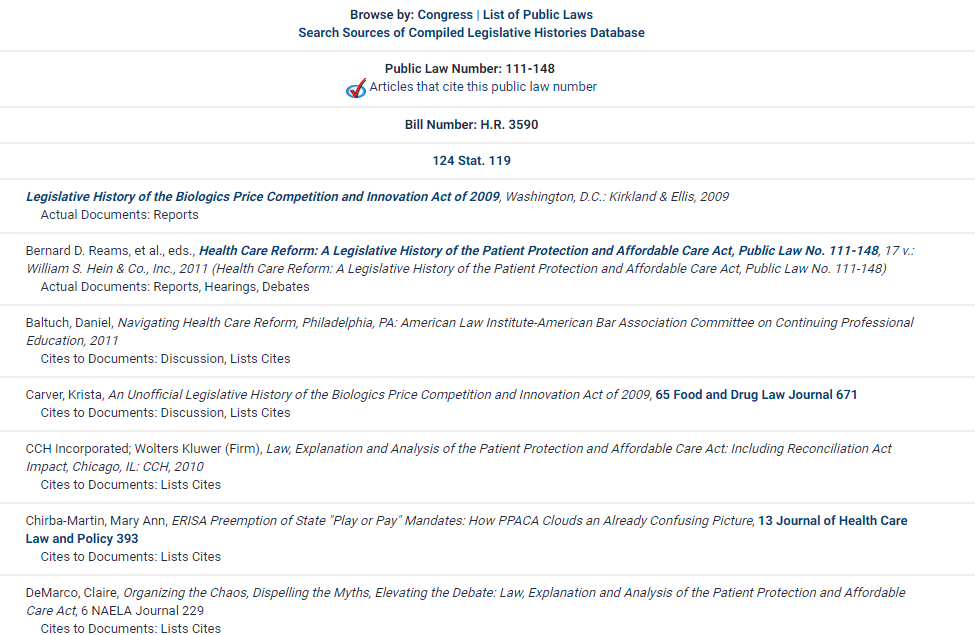
NOTE: Subject-specific legislative histories may only be available in their corresponding HeinOnline collections.
For help searching or navigating HeinOnline, contact our dedicated support team (800) 277-6995, email us, or chat with us!
Be sure to follow HeinOnline on Twitter, Facebook, Instagram, and YouTube for search tips, content, and feature announcements.



